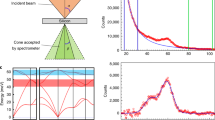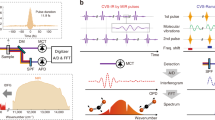Abstract
Vibrational spectroscopies using infrared radiation1,2, Raman scattering3, neutrons4, low-energy electrons5 and inelastic electron tunnelling6 are powerful techniques that can analyse bonding arrangements, identify chemical compounds and probe many other important properties of materials. The spatial resolution of these spectroscopies is typically one micrometre or more, although it can reach a few tens of nanometres or even a few ångströms when enhanced by the presence of a sharp metallic tip6,7. If vibrational spectroscopy could be combined with the spatial resolution and flexibility of the transmission electron microscope, it would open up the study of vibrational modes in many different types of nanostructures. Unfortunately, the energy resolution of electron energy loss spectroscopy performed in the electron microscope has until now been too poor to allow such a combination. Recent developments that have improved the attainable energy resolution of electron energy loss spectroscopy in a scanning transmission electron microscope to around ten millielectronvolts now allow vibrational spectroscopy to be carried out in the electron microscope. Here we describe the innovations responsible for the progress, and present examples of applications in inorganic and organic materials, including the detection of hydrogen. We also demonstrate that the vibrational signal has both high- and low-spatial-resolution components, that the first component can be used to map vibrational features at nanometre-level resolution, and that the second component can be used for analysis carried out with the beam positioned just outside the sample—that is, for ‘aloof’ spectroscopy that largely avoids radiation damage.
This is a preview of subscription content, access via your institution
Access options
Subscribe to this journal
Receive 51 print issues and online access
$199.00 per year
only $3.90 per issue
Buy this article
- Purchase on Springer Link
- Instant access to full article PDF
Prices may be subject to local taxes which are calculated during checkout



Similar content being viewed by others
References
Stuart, B. Infrared Spectroscopy: Fundamentals and Applications (Wiley, 2004)
Griffiths, O. R. & De Haseth, J. A. Fourier Transform Infrared Spectrometry 2nd edn (Wiley, 2007)
McCreery, R. L. Raman Spectroscopy for Chemical Analysis (Wiley, 2000)
Mitchell, P. C. H., Parker, S. F., Ramirez-Cuesta, A. J. & Tomkinson, J. Vibrational Spectroscopy With Neutrons (World Scientific, 2005)
Ibach, H. & Mills, D. L. Electron Energy Loss Spectroscopy and Surface Vibrations (Academic, 1982)
Stipe, B. C., Rezaei, M. A. & Ho, W. Single molecule vibrational spectroscopy and microscopy. Science 280, 1732–1735 (1998)
Dai, S. et al. Tunable photon polaritons in atomically thin van der Waals crystals of boron nitride. Science 343, 1125–1129 (2014)
Haider, M., Braunshausen, G. & Schwann, E. Correction of the spherical aberration of a 200 kV TEM by means of a hexapole-corrector. Optik 99, 167–179 (1995)
Krivanek, O. L., Dellby, N., Spence, A. J., Camps, R. A. & Brown, L. M. Aberration correction in the STEM. Inst. Phys. Conf. Ser. 153, 35–40 (1997)
Haider, M. et al. Electron microscopy image enhanced. Nature 392, 768–769 (1998)
Batson, P. E., Dellby, N. & Krivanek, O. L. Sub-Ångstrom resolution using aberration corrected electron optics. Nature 418, 617–620 (2002)
Erni, R., Rossell, M. D., Kisielowski, C. & Dahmen, U. Atomic-resolution imaging with a sub-50-pm electron probe. Phys Rev. Lett. 102, 096101 (2009)
Krivanek, O. L. et al. Atom-by-atom structural and chemical analysis by annular dark field electron microscopy. Nature 464, 571–574 (2010)
Suenaga, K. & Koshino, M. Atom-by-atom spectroscopy at graphene edge. Nature 468, 1088–1090 (2010)
Zhou, W. et al. Direct determination of the chemical bonding of individual impurities in graphene. Phys. Rev. Lett. 109, 206803 (2012)
Ramasse, Q. M. et al. Probing the bonding and electronic structure of single atom dopants in graphene with electron energy loss spectroscopy. Nano Lett. 13, 4989–4995 (2013)
Krivanek, O. L., Lovejoy, T. C., Dellby, N. & Carpenter, R. W. Monochromated STEM with a 30 meV-wide, atom-sized electron probe. Microscopy 62, 3–21 (2013)
Boersch, H., Geiger, J. & Stickel, W. Interaction of 25-keV electrons with lattice vibrations in LiF. Experimental evidence for surface modes of lattice vibration. Phys. Rev. Lett. 17, 379–381 (1966)
Terauchi, M., Tanaka, M., Tsuno, K. & Ishida, M. Development of a high energy-resolution electron energy loss spectroscopy microscope. J. Microsc. 194, 203–209 (1999)
Walls, M. G. & Howie, A. Dielectric theory of localized energy loss spectroscopy. Ultramicroscopy 28, 40–42 (1989)
Cohen, H. et al. Near-field electron energy loss spectroscopy of nanoparticles. Phys. Rev. Lett. 80, 782–785 (1998)
Garcia de Abajo, F. J. & Howie, A. Electron spectroscopy from outside – aloof beam or near field? Inst. Phys. Conf. Ser. 161, 327–330 (1999)
Howie, A. & Milne, R. H. Excitations at interfaces and small particles. Ultramicroscopy 18, 427–4334 (1985)
Wang, Z. L. Valence electron excitations and plasmon oscillations in thin films, surfaces, interfaces and small particles. Micron 27, 265–299 (1996)
García de Abajo, F. J. Optical excitations in electron microscope. Rev. Mod. Phys. 82, 209–275 (2010)
Cueva, P. & Muller, D. A. Atomic-scale optical and vibrational spectroscopy with low loss EELS. Microsc. Microanal. 19 (suppl. 2). 1130–1131 (2013)
Dwyer, C. Localization of high-energy electron scattering from atomic vibrations. Phys. Rev. B 89, 054103 (2014)
Rez, P. Is localised infra red spectroscopy now possible in the electron microscope? Microsc. Microanal. 20, 671–677 (2014)
Lovejoy T. C et al. Energy-filtered high-angle dark field mapping of ultra-light elements. Microsc. Microanal. 20, (suppl. 3)558–559 (2014)
Pennycook S. J., Nellist P. D., eds. Scanning Transmission Electron Microscopy (Springer, 2011)
Spurr, A. R. A low-viscosity epoxy resin embedding medium for electron microscopy. J. Ultrastruct. Res. 26, 31–43 (1969)
Egerton, R. F. Electron Energy Loss Spectroscopy in the Electron Microscope 3rd edn (Springer, 2011); http://www.tem-eels.ca/computer-programs/index.html
Tiemeijer, P. C., van Lin, J. H. A., Freitag, B. H. & de Jong, A. F. Monochromized 200 kV (S)TEM. Microsc. Microanal. 8 (suppl. 2). 70–71 (2012)
Krivanek, O. L., Gubbens, A. J., Dellby, N. & Meyer, C. E. Design and first applications of a post-column imaging filter. Microsc. Microanal. Microstruct. 3, 187–199 (1992)
Gubbens, A. J. et al. The GIF Quantum, a next generation post-column imaging energy filter. Ultramicroscopy 110, 962–970 (2010)
Krivanek, O. L. et al. Towards sub-10 meV energy resolution STEM-EELS. Inst. Phys. Conf. Ser. 522, 012023 (2014)
Krivanek, O. L. et al. An electron microscope for the aberration-corrected era. Ultramicroscopy 108, 179–195 (2008)
Krivanek, O. L., Chisholm, M. F., Dellby, N. & Murfitt, M. F. in Scanning Transmission Electron Microscopy: Imaging and Analysis (eds Pennycook, S. J. & Nellist, P. D. ) 613–656 (Springer, 2011)
Bock, J. & Gouq-Jen, S. Interpretation of the infrared spectra of fused silica. J. Am. Ceram. Soc. 53, 69–73 (1970)
Oshima, C. & Nagashima, A. Ultra-thin epitaxial films of graphite and hexagonal boron nitride on solid surfaces. J. Phys. Condens. Matter 9, 1–20 (1997)
Li, P. J. et al. Structural characterization of nm SiC films grown on Si. Appl. Phys. Lett. 62, 3135–3137 (1993)
Bashkin, I. O. et al. Hydrogen interaction and bound multiphonon states in vibrational spectra of titanium hydrides. Z. Phys. Chem. 179, 335–342 (1993)
Acknowledgements
We thank A. Howie and J.-C. Idrobo for discussions, W. J. Bowman, J. Bruley, J. H. Butler, V. Domnich, R. A. Haber, Y. Ikuhara, M. R. Libera, D. S. Lowry and V. Nicolosi for provision of samples, J. Mardinly for help with running the instruments, our co-workers at Nion, especially N. J. Bacon, G. J. Corbin, P. J. Cramer, Z. Dellby, R. W. Hayner, P. Hrncirik, P. Phoungphidok, M. C. Sarahan, G. S. Skone, Z. Szilagyi and T. Yoo for help with the construction of the hardware, electronics and software for HERMES, and C. Trevor of Gatan Inc. for an instability-analysing script. We also acknowledge the use of facilities within the LeRoy Eyring Center for Solid State Science at Arizona State University. Financial support for the purchase of the microscopes was provided by National Science Foundation grants DMR MRI 0821796 (Arizona State University) and DMR MRI-R2 959905 (Rutgers University). Department of Energy grant DE-SC0004954 provided support for P.A.C. and microscopy performed at Arizona State University, and Department of Energy grant DE-SC0005132 provided support for P.E.B., M.J.L. and microscopy performed at Rutgers University. Additional support was provided by the Department of Energy (grant DE-SC0007694), the Natural Sciences and Engineering Council of Canada, the UK Engineering and Physical Research Council (capital equipment grant EP/J021156/1), Arizona State University, Rutgers University and Nion Co.
Author information
Authors and Affiliations
Contributions
P.A.C., O.L.K. and P.R. initiated the project, P.A.C., O.L.K. and J.Z. prepared samples, T.A., P.E.B., N.D., O.L.K., M.J.L., T.C.L. and J.Z. obtained electron microscope spectra and images, P.A.C. and E.S. obtained infrared and Raman spectra, T.C.L., N.D., R.F.E. and J.Z. analysed EELS results, P.R. performed theoretical simulations, P.E.B., R.W.C., N.D., R.F.E., O.L.K., T.C.L. and P.R. advised on theoretical interpretation, P.E.B., O.L.K., T.C.L. and E.S. prepared the figures, and O.L.K. and P.R. wrote the paper. All the authors read and commented on the manuscript.
Corresponding authors
Ethics declarations
Competing interests
N.D., O.L.K. and T.C.L. have a financial interest in Nion Company.
Extended data figures and tables
Extended Data Figure 1 Analysis of total system instabilities, performed by plotting the position of the ZLP on the EEL spectrometer detector as a function of time.
a, Using the Gatan Enfinium EELS and original power supplies: ∼50 meV peak-to-peak and 12 meV r.m.s. instability. b, As a but with improved-stability power supplies: ∼18 meV peak-to-peak and 4.5 meV r.m.s. instability. c, Single magnetic sector EELS with Nion power supplies: ∼12 meV peak-to-peak and 3 meV r.m.s. instability. Panels a and b show the position of the ZLP on the EELS detector as a function of time, marking each position of the ZLP with a single point; c shows the whole ZLP profile, together with a blue trace that follows the instantaneous position of the centre of the profile.
Extended Data Figure 2 Raman spectrum of epoxy resin.
The major peak is centred on 2,920 cm−1 = 362 meV.
Extended Data Figure 3 Fall-off of the h-BN LO phonon signal in the vacuum, probed out to 300 nm.
a, HAADF image of an edge of a BN particle of nearly constant thickness, with the probed line indicated by a yellow arrow. b, Shown are the intensity of the BN phonon signal peak (at 173 meV) along the probed line (blue diamonds), the Ko model of the phonon signal decay in vacuum (dotted blue line), the exponential model of the same (dotted red line), and approximate sample thickness (green triangles). The edge of the particle is at R = 0.
Rights and permissions
About this article
Cite this article
Krivanek, O., Lovejoy, T., Dellby, N. et al. Vibrational spectroscopy in the electron microscope. Nature 514, 209–212 (2014). https://doi.org/10.1038/nature13870
Received:
Accepted:
Published:
Issue Date:
DOI: https://doi.org/10.1038/nature13870
This article is cited by
-
Shortwave absorption by wildfire smoke dominated by dark brown carbon
Nature Geoscience (2023)
-
Time-resolved transmission electron microscopy for nanoscale chemical dynamics
Nature Reviews Chemistry (2023)
-
Atomic-scale origin of the low grain-boundary resistance in perovskite solid electrolyte Li0.375Sr0.4375Ta0.75Zr0.25O3
Nature Communications (2023)
-
Single-atom vibrational spectroscopy with chemical-bonding sensitivity
Nature Materials (2023)
-
Phonon transition across an isotopic interface
Nature Communications (2023)
Comments
By submitting a comment you agree to abide by our Terms and Community Guidelines. If you find something abusive or that does not comply with our terms or guidelines please flag it as inappropriate.



